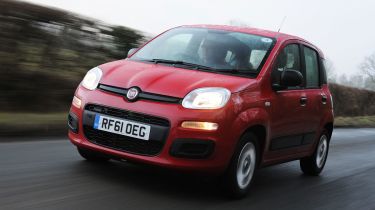Fiat Panda 1.2 Easy
Newcomer looks great, so can it back up style with substance?
This is only the third new Fiat Panda to be introduced in 32 years, so fans of the little runabout can perhaps be forgiven for getting excited.
The Panda has always had a friendly charm, and this has been successfully retained in the styling of the MkIII model. Longer, wider and taller than the outgoing car, the newcomer has rounded-off lines that create what Fiat describes as a “soft cube”. The modern face, curved wheelarches and big glass area give a simple yet attractive look.
The car in our pictures is an entry-level Pop, and does without the rugged roof bars of our Easy-spec test model.
Inside, the rounded theme is carried over to the switchgear, instruments, gearlever and even the handbrake. There’s also a storage bin ahead of the front-seat passenger that takes its inspiration from the original Panda. Overall, the simple yet smart dash works well.
The gearlever mounted high on the centre console reminds you of the previous Panda’s layout, but material quality has been greatly improved. Yet there is still some sharp-edged plastic in out-of-the-way places, and the Kia Picanto feels more upmarket in comparison.
A bigger concern if you regularly carry a full load of passengers will be the lack of rear legroom. Although the cabin is now 20mm longer, most people will still find that their knees touch the front seatbacks when they sit in the back of the Panda – and that’s not really a complaint we can level at its rivals here.
Used - available now

2020 Hyundai
i20
39,441 milesManualPetrol1.0L
Cash £10,771
2020 Hyundai
Tucson
46,895 milesAutomaticPetrol1.6L
Cash £15,741
2023 Hyundai
Tucson
17,416 milesAutomaticPetrol1.6L
Cash £20,885
2022 Hyundai
Ioniq 5
25,000 milesAutomaticElectric
Cash £22,997On top of that, Fiat charges £50 for a full complement of three rear headrests and seatbelts, plus another £50 for split folding seats. Still, the 225-litre boot is a match for the i10’s, while a sliding rear bench will be added to the options list from September.
Up front, the lack of a standard height-adjustable seat (it’s another £50 option) can leave you feeling perched up high, but visibility is good and light controls make the Panda an absolute breeze to drive. The turning circle is very tight, and as before, there’s a City button that makes the steering finger-tip sensitive. Stability when driving on the motorway is excellent, while a stiffer body, new suspension and revised bushings have all helped to lessen road noise.
These chassis changes have also reduced roll, improved the ride and made the Panda more composed on country roads. The steering is light, but the Fiat turns in neatly and tidy handling and superior comfort give it the upper hand over its rivals.
The 1.2-litre petrol in our test car has been carried over from the previous Panda and is expected to be the most popular engine in the UK. With 69bhp, the Fiat loses out to the Hyundai on power and trails it by 3.5 seconds from 0-60mph, with a time of 14.4 seconds.
It feels strained at high revs, but throttle response is decent. And despite delivering 19Nm less torque than the i10, at 102Nm, the Panda was quicker than both rivals in our in-gear tests.
The Fiat’s 1.2-litre is the only engine in the range that doesn’t get a stop-start system as standard, and while we weren’t able to record meaningful fuel consumption data during our test, Fiat’s official figures suggest it will be the least economical of this trio.
Unfortunately, the numbers don’t stack up well for the Panda when it comes to standard kit, either. Alloys, electric mirrors, split-fold rear seats and body-colour side mouldings are all optional on the Easy model. The Hyundai and Kia get all this and more as standard.
Fiat’s warranty can’t match rivals’, either. Yet the Panda is still very likeable. It’s good to drive, looks great and has plenty of character – all of which counts for a lot in this class. The Panda’s charm has been winning over small-car buyers for the last three decades, and the new model should continue to do so.
Details
Chart position: 2
WHY: Latest Panda is redesigned inside and out, and promises to be better to drive and more practical than ever. We test the middle-of-the-range Easy trim.







